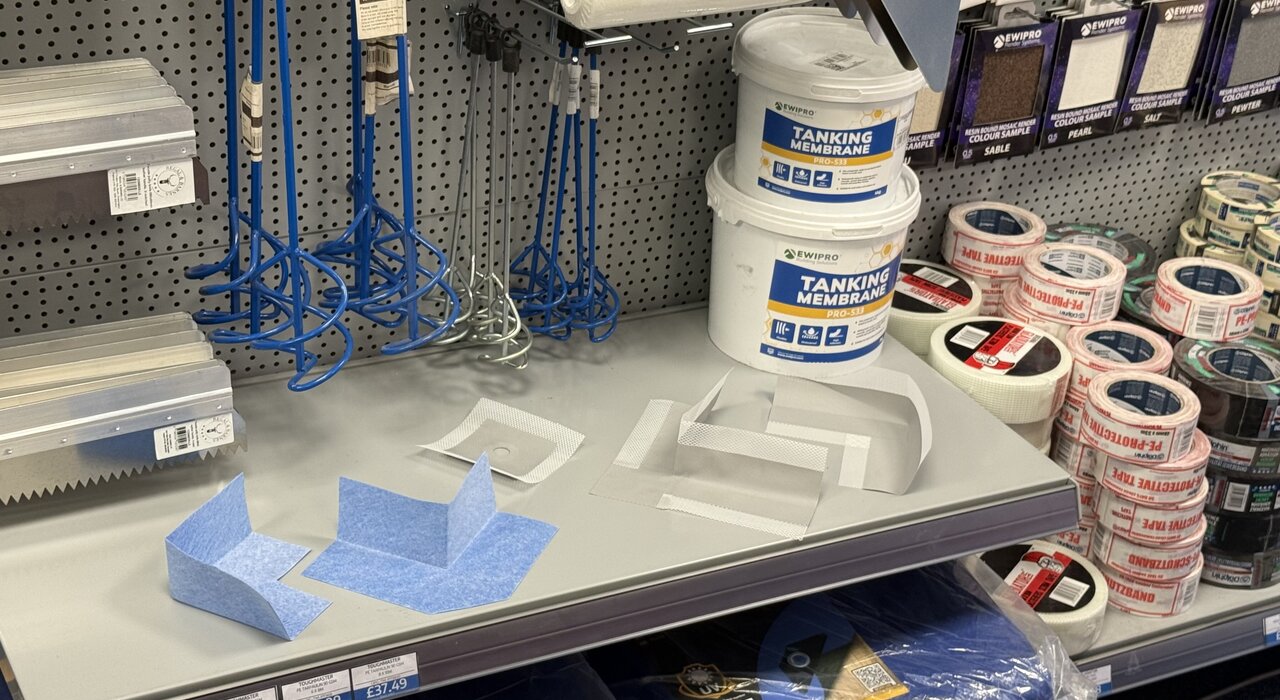
- Do You Need to Waterproof a Bathroom in the UK?
- How to Tank a Bathroom Step by Step
- Liquid vs Membrane Tanking: Which Is Best?
- Sheet/Fleece Membranes
- Recommended products from EWI Store:
- Where Should You Tank in a Bathroom?
- Common Tanking Mistakes (to Avoid)
- Best Bathroom Tanking Products
- Bathroom Tanking FAQ
What Is Bathroom Tanking?
Bathroom tanking is the process of applying a waterproof barrier beneath tiles and finishes in areas exposed to water. It’s essential for protecting walls, floors, and structures in showers, wetrooms, and around baths.
Tiles and grout may resist water, but they are not fully waterproof. Over time, moisture seeps through joints or failed sealant, causing rot, mould, and costly damage. A tanking system creates a continuous, watertight layer that keeps your bathroom leak-free for the long term.
👉 Explore our full range of bathroom tanking systems.
Do You Need to Waterproof a Bathroom in the UK?
Yes — in any wet zone, tanking is strongly recommended.
- UK Building Regulations Part C requires resistance to moisture ingress, particularly in bathrooms.
- Warranty providers (NHBC, new-build developers) expect waterproofing as part of best practice.
In short: if you’re tiling a shower, wetroom, or bath area, waterproofing is not optional.
How to Tank a Bathroom (Step by Step
How to Tank a Bathroom Step by Step
- Prepare the substrate – Use cement boards or waterproof tile backer boards in wet zones.
- Apply primer – Ensure the tanking system bonds securely to the surface.
- Seal junctions and penetrations – Use tanking tape, corners, and pipe collars to cover weak points.
- Apply waterproof membrane – Roll or brush on a liquid membrane (two coats) or install sheet/fleece-backed membranes.
- Cure fully – Let the system dry before tiling (typically 12–24 hours).
- Tile and finish – Use a flexible adhesive suitable for waterproofed surfaces.
Liquid vs Membrane Tanking: Which Is Best?
Liquid Tanking Systems
- Easy to apply with brush or roller.
- Ideal for walls and smaller enclosures.
- Creates a seamless, flexible layer.
Recommended product: EWI Pro Tanking Membrane (EWI-533) – a high-performance liquid acrylic membrane for domestic and commercial wet zones.
Sheet/Fleece Membranes
- Perfect for full wet rooms, timber floors, or high-movement substrates.
- Include dedicated tapes, corners, and collars for leak-prone areas.
- Extremely durable and long-lasting.
Recommended products from EWI Store:
- TECH-BAU Fleece-Backed Tanking Tape – for board joints and wall-to-floor junctions.
- TECH-BAU Fleece-Backed Corners – for internal and external corners.
- TECH-BAU Pipe Collars – for watertight pipe penetrations.
Where Should You Tank in a Bathroom?
- Inside shower enclosures
- Wetroom floors and walls
- Bath surrounds and floors around baths
- Floor-to-wall junctions
- Any tiled area regularly exposed to water spray
Even in “dry-looking” layouts, overspray and condensation can cause long-term damage without waterproofing.
Common Tanking Mistakes (to Avoid)
- Skipping junctions and pipe penetrations
- Applying too thinly (most require two coats)
- Using incompatible adhesives and membranes
- Failing to cure before tiling
- Waterproofing over plasterboard in wet zones instead of using cement board
Best Bathroom Tanking Products
- EWI Pro Tanking Membrane (EWI-533) – liquid membrane for walls and splash zones.
- TECH-BAU Fleece-Backed Tanking Tape – seals vulnerable joints.
- TECH-BAU Fleece-Backed Internal & External Corners – quick and reliable detailing.
- TECH-BAU Pipe Collars – perfect for mixer outlets and shower valves.
Bathroom Tanking FAQ
What is bathroom tanking?
It’s the process of applying a waterproof barrier beneath tiles in wet zones to stop water reaching the structure.
Do I need to waterproof the whole bathroom?
Not always. Tank all wet zones (showers, wetrooms, around baths) and seal junctions.
Can I tile directly onto plasterboard?
Not in wet zones. Use cement board or a waterproof backer board.
Which is better: liquid or sheet membrane?
Liquids are great for walls and small areas. Sheet/fleece systems are best for floors, wetrooms, and timber substrates.
How much does bathroom tanking cost in the UK?
DIY kits start from ~£60. Professional installations range from £300–£700 depending on size and complexity.
Conclusion: Why Choose EWI Store Tanking Systems
Waterproofing is the hidden foundation of a long-lasting bathroom. By tanking your wet zones with a reliable system, you protect your home from leaks, mould, and structural damage.
At EWI Store, we stock everything you need — from liquid membranes to fleece-backed tapes, corners, and collars— all engineered to work together. With one of the UK’s widest ranges of tanking solutions, you can be confident your bathroom will stay watertight for years to come.
